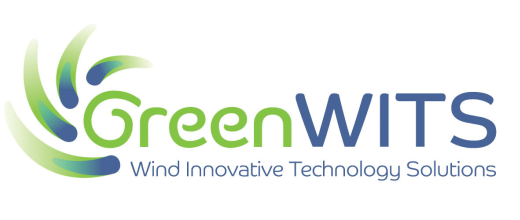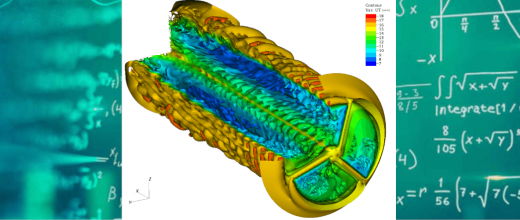Sailing boats, windmills, etc. Humans have made use of wind energy for centuries. Thanks to technological progress, today it is possible to produce “green” electricity without using fossil resources. We take a closer look at its development prospects and the remaining challenges to be overcome.
- Wind energy: a few definitions
- How does a wind turbine work?
- From wind turbines on land to offshore wind turbines
- Offshore wind, a fixed or floating turbine?
- Immense onshore and offshore potential
- Offshore wind, a future El Dorado for Europe and France?
- Advantages of wind energy
- Challenges of wind energy
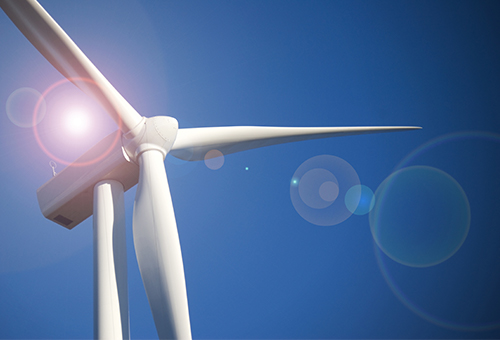
WIND ENERGY: A FEW DEFINITIONS
A wind turbine is a machine used to convert kinetic energy from the wind into mechanical energy, in turn converted into electricity. When several wind turbines are installed on the same site, this is called a “wind park” or “wind farm”.
The first wind turbines used to produce electricity date back to the 1970s. In France today, wind power is the second most used renewable energy source behind hydropower. It supplies more than 8% of national electricity requirements (8,3% in 2022, that is 37.9 TWh).
In France, wind power supplies more than 8% of national electricity requirements.
HOW DOES A WIND TURBINE WORK?
Wind energy is produced thanks to the force exerted by the wind on the blades of a rotor.
In its most common configuration, the rotor has 3 blades rotating around a horizontal axis. The sweep diameter of these blades ranges from 80 to more than 200 meters. The longer the blades, the greater the electricity production capacity.
As they rotate, the rotor drives a generator that produces electric energy. With conventional wind turbines, the electric generator requires a rotation speed of 1,000 to 2,000 rpm, whereas the blades turn more slowly (5 to 25 rpm). With these wind turbines, a multiplier (or gear box) is installed between the rotor and the generator to increase the rotation speed. More recently, direct-drive machines have been designed: with these, the generators operate with a variable rotation speed (5 to 2,000 rpm) and do not use a multiplier. The assembly composed of the multiplier and the generator forms the nacelle.
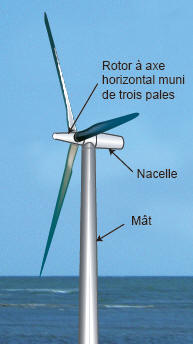
The nacelle is installed at the top of a tower that is between 50 and over 200 m high. A rotation system turns the rotor and blades so that they are always facing into the wind. Wind turbines generally operate at wind speeds of between 10 and 90 km/h. Beyond this maximum speed, they stop automatically to avoid any accidents.
The electric energy produced by the generator is transported down the tower via cables to a transformer, before being injected into the electricity grid by underground cables.
FROM WIND TURBINES ON LAND TO OFFSHORE WIND TURBINES
The first wind turbines built on land were followed by offshore wind turbines. This is because onshore technology has several limitations:
• a maximum power that rarely exceeds 3 to 4 MW,
• sometimes poor acceptability to society,
• conflicts of use that complicate site availability
Offshore, winds are more powerful and regular than on land, which has driven the development of offshore wind farms in recent years. Larger and more powerful (6 to 10 MW, or even 18 MW for some recent models), wind turbines installed in the sea supply more energy per machine than wind turbines on land. They have a limited impact on the landscape, making it possible to have larger wind parks, with more turbines. Manufacturing, installation and production costs are higher than the onshore equivalent but they are likely to fall over time.
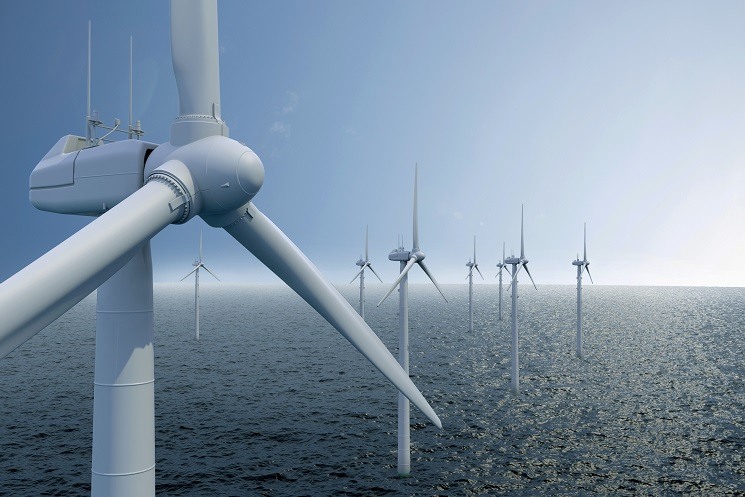
OFFSHORE WIND: A FIXED OR FLOATING TURBINE ?
When it comes to anchoring wind turbines to the seabed, there are two options, depending on water depth:
• fixed wind turbines: at depths of up to 60 meters, the wind turbines are fixed to the seabed. Fixed offshore wind power technologies are already well developed, but bigger and more powerful turbines will be needed to reduce operating costs. In Europe, the UK leads the way in terms of installed capacity, followed by Germany, the Netherlands and Denmark;
• floating wind turbines: at depths of over 60 meters, fixing to the seabed becomes too expensive and difficult. The wind turbines are therefore connected to a floating support on the surface of the water, or just below it. They can be located further from the shore and therefore benefit from stronger and more regular winds. The floating support is anchored to the seabed using cables. Several types of floaters can be used, including a barge, a steel column or several steel columns, etc. These structures have to be able to tolerate extreme sea conditions and their manufacturing costs have to be kept under control.
Did you know ?
While wind turbines have been used to produce electricity since the end of the 19th century, it was not until the 1970s, after the first oil crisis, that onshore wind really began to take off, particularly in Denmark. And it was Denmark too that installed the first offshore wind turbine, in 1991. In 2021, in Europe, there were 116 offshore wind farms in 12 countries, representing a total of 5,000 turbines. The floating offshore wind sector is emerging in Europe with the installation, off the coast of Scotland, of two windfarms: Equinor’s HyWind site (30 MW) in 2017 and Kincardine (50 MW) in 2021. The new farm of Equinor, Hywind Tampen, is set to beat a new record, with a total capacity of 88 MW. Its production began at the end of 2022. Four parks are underway in France, three of which are located in the Mediterranean, including that of Provence Gand Large with a capacity of 25MW for which IFPEN participated in the dimensioning of the floating foundations. Its achievement is scheduled for the second half of 2023.
IMMENSE INSHORE AND OFFSHORE WIND POTENTIAL
Global onshore wind energy potential, according to the World Wind Energy Association (WWEA), would make it possible to provide around 200,000 TWh of electricity per year, assuming turbines operate for 2,100 hours during the year.
A study conducted by the Universities of Sussex (England) and Aarhus (Denmark) estimates European onshore potential (including Russia and Turkey) to represent 110,000 TWh per year. It would require the installation of 11 million additional wind turbines, across an area of 4.9 million square kilometers.
Offshore wind
• 420,000 TWh
The global annual offshore wind potential, according to the International Energy Agency, which represents 18 times the world demand for electricity (11 times the forecast demand in 2040). In Europe, offshore wind potential is 34,000 TWh per year, for a demand that does not exceed 3,000 TWh. In France, according to France Energie Eolienne, the theoretical resource could provide 168 TWh per year and 294 TWh per year for fixed wind and floating wind power respectively. The total is slightly above the energy consumed in France in 2020 (460 TWh) according to RTE, the French electricity network operator.
OFFSHORE WIND, A FUTURE EL DORADO for EUROPE AND FRANCE ?
Europe is ahead of the field in terms of offshore electricity production, with the United Kingdom leading the world.
The European Commission’s ambition is for there to be a five-fold increase in existing capacity by 2030 and a 25-fold increase by 2050.
In France, the projects set out within the framework of the French long-term energy plan (PPE) were aimed at establishing an installed offshore wind energy capacity of 2.4 GW in 2023 and around 5 GW in 2028. Although the objective set in 2023 will not be completely achieved, the ambition of the public authorities remains strong, as evidenced by the "Offshore Wind Pact" signed in March 2022 with the aim of increasing the installed capacity to 18 GW in 2035. and 40 GW in 2050. To monitor the progress of ongoing projects, the Ministry of Ecological Transition has set up a very educational website Eoliennes en mer en France.
THE MAJOR ADVANTAGES OF WIND ENERGY
- Wind power makes it possible to diversify energy resources. Established on the national territory, it contributes to energy independence and the security of a proportion of supplies.
- Wind energy is renewable and non-polluting. It helps improve air quality and reduce global warming since electricity is produced without CO2 emissions. The manufacture and end of life of installations generate little CO2. Moreover, electricity can be produced close to the places of consumption.
- Once utilized, sites can be restored to their original condition and materials can be reused.
Despite its advantages, wind energy presents a number of challenges, including its intermittent nature, social acceptability, the reinforcement of electricity grids, pressure on raw materials, cost reduction and risk minimization.
Intermittence
Wind energy is intermittent: the blades only operate if the wind is neither too light nor too strong. If there is no wind, electricity has to be generated by other sources of production, ideally renewable such as hydroelectric, biomass or geothermal power plants.
In contrast, if too much electricity is generated, energy storage systems can be used, such as giant batteries, pumping systems, gravity storage, flywheel storage. There are also plans to produce hydrogen via water electrolysis (power-to-gaz).
Social acceptability
More and more people are beginning to understand the importance of developing wind energy. Nevertheless, more research is required to better evaluate the impacts of wind turbines, particularly on fauna (birds, bats, etc.). In the offshore environment, conflicts of use with the fishing industry and leisure sailing/yachting sector must be evaluated for each new potential wind farm project.
Electricity grid reinforcement
Electricity networks need to be adapted to transport ever increasing volumes of electricity. This will require significant investments.
Raw material pressures
The large-scale roll-out of wind turbines will significantly increase the demand for raw materials, particularly metals such as copper or certain rare eaths, required to manufacture and connect them. This pressure on resources is the focus of prospective research, particularly at IFPEN, which contributed to an ANR project aimed at more precisely evaluating the reliance on metals that could result from the energy transition. The recycling of metals and other turbine components would go some way to meeting this demand.
Cost reduction and risk minimization
In France, the cost of onshore wind power is €60-70/MWh, while that of fixed offshore wind is €40-80/MWh and that of less mature floating offshore wind is €120-150/MWh. By way of comparison, photovoltaic energy costs between €45 and €81/MWh and nuclear between €43.8 and €64.8/MWh. Evolving technologies should enable a significant reduction in the costs of wind power by 2030, particularly on floating wind power.
To reduce the costs and risks associated with wind energy, modeling and forecasting tools may prove extremely useful and are the focus of research conducted at IFPEN and elsewhere. This research is aimed at optimizing the positioning of wind turbines on farms, estimating the energy produced, predicting, in real time, prevailing wind characteristics (strength, direction) and making the best use of it, improving productivity and maintenance by detecting faults on wind turbines, etc.







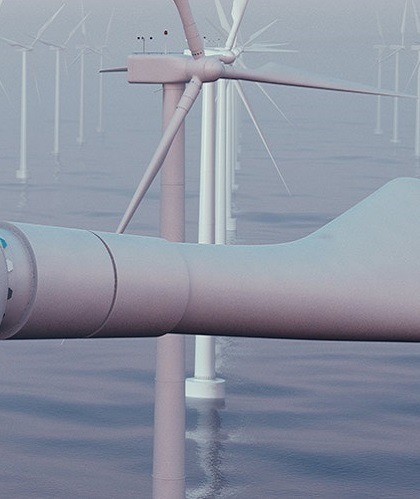 Our solutions >
Our solutions > 